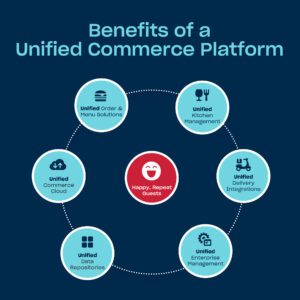But the restaurant world has changed drastically, and the role of POS must change with it.
Client-server and first-gen cloud POS wasn’t designed to handle the challenges facing restaurant chains in 2023. Not to mention rapidly evolving guest demands. That’s why it’s time to change our old habit of relying on POS as the center (and stuck point) of the restaurant ordering universe.
It’s time to view the POS as the piece of the tech system, not the system itself, and certainly not the core.
In the new world order, POS is simply one order channel of many that now finds its home within a larger “commerce platform” environment. In our annual state of digital survey, 50% of fast casual and QSR brands said they’ll be switching to a “unified commerce platform” over the next 2 years.
But what exactly is a unified commerce platform?
Qu’s Definition of a Unified Commerce Platform
A “true” unified restaurant commerce platform is a data-driven foundational framework that unifies the ordering journey across brands, channels, and systems; resulting in real-time access to all order data.
It provides ONE place to control all your commerce functions
One big area where POS consistently fails restaurant operators is with unifying the data.
Try normalizing data that’s created across 5 to 10 different front-end systems (i.e, web ordering, apps, DSPs, POS, Kiosk) all with different payment services. Add in loyalty, labor and inventory data and it’s nearly impossible to normalize data in any acceptable timeframe. It’s death by a thousand cuts.
But merging digital and physical order channels using a singular data creation layer that’s intentionally built on a unified commerce platform closes the loop on data and reporting. It delivers holistic, real-time insights, while still allowing for best-in-class integrated solutions.
A key defining trait of a unified commerce platform is that it embraces and encourages these open integrations while staying true to its higher purpose of unifying data, brand, and channel management. The platform features:- Unified menu management – across channels and across brands
- Unified data models – normalized at the source, not after the fact
- Unified ordering & fulfillment processes – from guest to kitchen and back to the guest
- Unified cloud – public and in-store clouds work in harmony to offer better speed and redundancy
- Unified multi-brand portfolio management – supports the ever growing ecosystem of multi-brand operators
- Unified tech stack & architecture – built from the ground-up for enterprise restaurant brands

Back to our old habit of relying on limited POS systems. What changes with a unified platform?
A unified commerce platform relieves the burden placed on the POS.
The POS becomes simply one of many ordering channels branching off from its foundational data model, with the right architecture (micro-services, ideally) providing the unifying force to empower your front- and back-of-house systems.
How Others Define Unified Commerce
OK – so what are some other definitions out there? There are many “platform providers” emerging in the restaurant technology space and it can be confusing separating the wheat from the chaff.
PRO TIP: Be sure to look under the hood and ask some key questions that will help you decide if the platform is truly unified, or is actually “frankensteined” together.
Here is what a unified commerce platform is NOT:
- An all-in-one solution. It’s not a homegrown or single vendor all-in-one solution that does a little of everything, but the best of nothing. A unified commerce platform is a foundational platform that integrates best-in-class systems of YOUR choosing.
- Digital commerce-only. It’s not a Digital-Only platform no matter how many native and 3rd party ordering channels it unifies. Digital platforms are great, but a unified commerce platform combines the best of both worlds – on-premises and off-premises orders from any channel.
- Built through acquisitions. It’s not pieces of acquired companies/products that are merged together into a Jenga-like tech stack, lacking the unified data foundation you need to scale into the future.
- It’s not owned by a payments company. You get to pick the payments partner of your choice and renegotiate favorable rates to best support your business.

Unified Commerce Platform Must-Haves
If you’re still not sure of the different between POS and various “connected platforms” think about what it enables in your restaurant operations.
A unified restaurant commerce platform provides functionality that truly connects your various systems and ordering processes to drive maximum efficiencies on- and off-prem. Here’s what it should do:
- Centralize in-store and digital ordering
- Streamline ordering and kitchen fulfillment processes (order accuracy)
- Automate manual, redundant processes (rekeying digital orders in POS?!)
- Normalize data from disparate sources
- Create new revenue-generating opportunities (think: deploy LTOs faster)
- Continually innovate and rapidly integrate new technologies
- Provide a stable foundation, that keeps your doors open and transactions flowing!
Times have changed, and the technology restaurants depend on must change and adapt accordingly.
So my invitation to you is to reframe how you strategically view, approach and plan technology decisions around your POS.
So my invitation to you is to reframe how you strategically view, approach, and plan technology decisions around your POS.
POS is neither Hero or Zero. It’s moved over from the Main Dish to the Side Dish.
POS is simply one ordering channel that’s part of a much larger ecosystem of ordering channels and technology solutions. And if you’re looking to drive operating efficiencies and collect full-picture data on your business—POS will continue to let you down.


